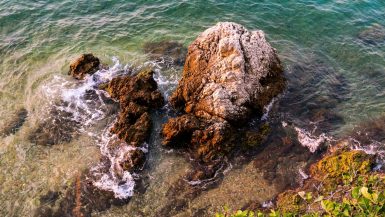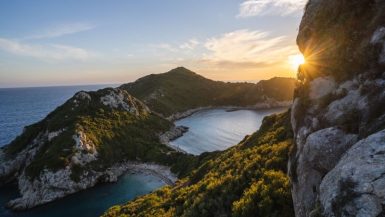
For the most part, Greece is very safe for visitors. However, there are some things to consider before booking your trip, from the risk of wildfires to the dangerous animals in Greece.
To be frank, scary critters aren’t nearly as big a worry as heatwaves and storms, pickpocketing in Athens or your usual travel scams. But there are some creatures that live between the golden beaches of the Peloponnese and the isles of the Aegean that can pose a threat to us humans.
Our guide to the deadliest animals in Greece will run through nine of the animals that we think you should be most wary of during your travels in the sunny country. It includes the slithering venomous snakes of Greece but also some – stray dogs, brown bears – that you might not have considered…
Horned viper (Vipera ammodytes)

The horned viper – also known as the ohia snake and the long-nosed viper – is, without question, the most deadly snake in the whole of Greece. They’re known to live all over southern Europe, from the tips of the Italian toe across the Balkan Peninsula, and down into the Greek islands and mainland.
A bite from these snakes won’t necessarily be fatal, but it can be, and so it is imperative to seek medical attention immediately if you believe you’ve been a victim. Horned vipers have a potent venom that’s worse than any other type of viper on the continent. On top of that, they possess large fangs and tend to inject a lot of stuff whenever they do bite.
Travelers like you and me typically encounter horned vipers in more rural areas of Greece. We’re talking places like dry farmland, vineyards, and rocky areas. When visiting any terrain like that, on hikes or wine tasting trips, be sure to have your wits about you. These vipers are particularly aggressive and protective of their space.
Ottoman viper (Montivipera xanthina)

The other potentially deadly snake that’s worth mentioning in our line up of the most dangerous animals in Greece comes in the form of the Ottoman viper. These guys get their name from the fact that they’re mainly found over the straits on the Turkish mainland. However, there have been increasing reports of sightings on the islands of the eastern Aegean – Lesbos, Patmos, Samos, Kos.
A fan of hot, semi-humid altitudes that have thick vegetation, forest coverage, and lots of undergrowth to hide in, this species of viper is a master of camouflage. They’re colored with dashes of woodland brown and mahogany, with only occasional cross lines of darker, coffee-brown marking the body from top to bottom.
Not all that much is known about the venom of the Ottoman viper. However, the studies that we do have point to a snake that’s got the ability to cause serious health complications in adult humans and even prove fatal in some cases. We know that their venom contains powerful haemotoxic compounds and other poisons capable of killing living cells in just a matter of hours.
Brown bear (Ursus arctos)

The brown bear is now an endangered species in Europe. Despite huge numbers of them roaming the countryside and mountains here centuries ago, hunters and habitat destruction have seen their populations dwindle. Once upon a time, they existed from Spain to Siberia. These days, they’re only around in the Alps, Scandinavia, and some portions of the Balkan States.
Today, Greece is home to approximately 450 brown bears. And numbers are on the up, too! Most of them reside in the rugged Pindos or Rodopis mountain ranges that score across the northern and eastern parts of the country. (Don’t worry – that’s plenty far away from the sun-kissed beach towns of the Cyclades islands!)
Still, there are now increasing reports of brown bears crossing paths with hikers on the trails of Greece’s more off-the-beaten-path regions. That can be a dangerous meeting, too, since these bulky customers can grow up to 2.5 meters in length and weigh in at 500 kilos! They’ve been known to charge walkers in Italy and Switzerland, and have even killed humans using their strong claws and bite.
Dogs (Canis familiaris)

How do we describe this one? Here goes: Fluffy fur, floppy ears, puppy eyes, a wagging tail. You know the critter we’re talking about? Yep, the much-loved Man’s Best Friend has a place on this list of the most dangerous animals in Greece for the sole reason that the home of feta and filo pastry counts some of the worst stray stats in the whole of Europe.
By some estimations, Greece – a country of just under 11 million people, mind you – has a whopping three million stray dogs in total. That’s nearly one stray pup per three people. But you hardly need a census to prove it. Head to virtually any town outside of central Athens and you’ll come across these lone street packs.
They present a unique danger to tourists in this part of the world. On the one hand, we’re sort of hardwired to want to get close to dogs and help them in a way that we never would with a snake or a brown bear. On the other, stray dogs are known vectors for bacterial infections and can cause serious physical harm with their bites. One upside: Greece has been officially rabies free since 2014.
Moray eels (Muraenidae)

The Mediterranean moray eel is a fairly common sight in the waters off the shores of Greece and its islands. They’re known to have high population numbers in the warmer southern seas of the country, particularly around the southernmost Cyclades islands and the largest isle of them all, Crete.
These slippery creatures are adept at hiding. They’re well camouflaged in patterns of dappled grey and yellow, which helps them to disappear between the rocks and reefs below the water. That’s where they often lie in wait for prey, emerging only to strike at unsuspecting crustaceans and molluscs – their favoured diet.
What you might not know is that moray eels are among the most dangerous critters in the sea. Their bites can be incredibly painful, and they are known to be very eager snappers. Worse still, the mucus of a moray eel contains toxins that are dangerous to humans, which means wounds can lead to infections and blood poisoning.
Stingray (Myliobatoidei)

There’s good news and bad news when it comes to stingrays in Greece. The good news is that they’re not known to be inordinately aggressive towards humans, so you are not likely to be attacked by a stingray unprovoked. The bad news? If they do attack it can be excruciatingly painful. So painful, in fact, that the Ancient Greeks were hugely scared of them and even claimed that their barbed tails could pierce their armour.
Not only are their tails barbed with razor-sharp fangs that can inflict deep wounds, but they also inject venom into the site of contact. Victims of stingrays often experience side effects such as muscle pains, vomiting, and diarrhea on top of the damage of the cuts from the barbs themselves.
If you exercise caution in the seas around Greece, as you always should, you are not at serious risk of suffering a stingray attack. If you do encounter one of these strange flat beasts, move away from it calmly and quickly and be sure not to make it feel threatened. Most of all, if you do suffer a sting from a stingray in Greece, seek medical attention immediately. Untreated wounds have been known to lead to amputation or even death in rare cases.
Portuguese man o’ war (Physalia physalis)

The Portuguese man o’ war may look like a jellyfish, but it’s not. It is a marine creature closely related to the jellyfish, made up of lots of small organisms that fulfill different functions, coming together to form one whole creature. The Portuguese Man O War is yet another of Greece’s scary and dangerous aquatic creatures that can pose a real threat to happy vacationers in the seas…
The Portuguese Man O War has been known to sting people all over the globe, from Australia to Europe. Worst of all, these suckers are renowned for the sheer agony of their stings, which have the power to kill adult humans.
The danger comes from the long, flowing tentacles that drop out of the bottom of the animal. They can be up to two meters in length and contain rows and rows of stinging cells that are usually deployed against small fish in the shallows where the man o’ war drifts. Touch one and you’ll get a dose of the venom, which causes initial tingling and searing pains up and down the limbs.
Blue shark (Prionace glauca)

Sharks are some of the most feared creatures on the planet. From Oz to the Eastern Seaboard of the USA, they put the heebie-jeebies into surfers and swimmers all over. And just before you go thinking that you’d be safe from these snappers of the deep blue sea when hitting the Greek beaches. Think again…
Greece is a known stomping ground of several large shark species. Among them, the blue shark. A fast and speedy swimmer that’s known as one of the most agile and nimble of the whole shark family, they’re regularly seen by yachters and boaters traveling in the open seas in these parts. They can also be spotted nearer to beaches and the shore, though that is rare.
It’s important to have some perspective here. First off, blue sharks aren’t known to attack humans regularly. They don’t have the whopping teeth of, say, a great white, and have only been known to bite 13 people in the last 400 years or so. Secondly, Greece isn’t a hotspot for shark attacks by any stretch – just 15 have occurred here in nearly two centuries.
Yellow scorpion (Buthus occitanus)

Sun-loving scorpions with their penchant for arid landscapes and dry, dusty habitats feel right at home in much of Greece. Truth is, they’re found all over the country in various subspecies. Some reside up in the northern mountains of Halkidiki, others prefer the scorched rocks of the islands further south.
It’s probably wise to be wary of all scorpions in Greece. There’s just no telling which are dangerous and which aren’t without having the right biology skills. However, one you’ll certainly want to steer away from is the common yellow scorpion. It comes from a branch of the scorpion tree that’s known to have particularly potent venom stored up in that stinger at the end of their tail.
The critter usually measures up to 80cm at full adulthood and has a unique brownish-beige color scheme that helps it meld in with the rocks and sands. They tend to live upwards of 800m and are most often found in rural areas. No deaths have been officially recorded from these guys, but stings are able to cause searing localized pain and complications in allergic people.

What’s the most dangerous animal in Greece?
The horned viper, also known as the ohia snake, is the most dangerous animal in Greece. Not only are they venomous and potentially fatal, but they are very common in the country. You are more likely to encounter this creature than a shark or a brown bear, which makes the risk of an attack much higher.
Are there any dangerous sea creatures in Greece?
Yes, there are dangerous sea creatures in the waters surrounding Greece and its islands. While there are sharks spotted around Greece, the most common sea creatures that pose the biggest threat to holidaymakers are stingrays and jellyfish.
Are there dangerous spiders in Greece?
Luckily for arachnophobes, there are no dangerous spiders in Greece. Yes, there is still an abundance of creepy-crawlies in Greece, and that includes spiders, but they mostly reside in Greece’s expansive forests and wooded areas. What’s more, no spiders in the land of feta and filo are known to be highly venomous.


